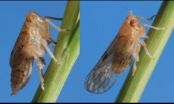Structure of genetic messenger molecules reveals key role in diseases
3-D structure of messenger molecules determine their stability and efficiency inside cells
2015-03-18
(Press-News.org) Messenger RNAs (mRNA) are linear molecules that contain instructions for producing the proteins that keep living cells functioning. A new study by UCL researchers has shown how the three-dimensional structures of mRNAs determine their stability and efficiency inside cells. This new knowledge could help to explain how seemingly minor mutations that alter mRNA structure might cause things to go wrong in neurodegenerative diseases like Alzheimer's.
mRNAs carry genetic information from DNA to be translated into proteins. They are generated as long chains of molecules, but they fold up into complex structures by making connections between different sections of the chain. Despite the importance of these structures to how mRNAs function, very little was known about them until now.
The study published in Nature reports a new technique allowing scientists to identify connections that hook sections of an mRNA together. "We were amazed to find that mRNAs make thousands of connections inside living cells", says Professor Jernej Ule (UCL Institute of Neurology) who led the research together with Dr Nicholas Luscombe (UCL Genetics Institute). "Sometimes these connections hook together very distant parts of mRNA molecules." Further investigation showed that these connections affect how mRNAs interact with other molecules inside cells, and so influence how much protein they eventually produce.
A particularly important connection is found in an mRNA that codes for a protein called X-box binding protein 1. "This protein enables our cells respond to stress. The amount of this protein in cells is tightly controlled, but when this control is lost, it can contribute to neurodegenerative diseases such as Alzheimer's," explains the study author Yoichiro Sugimoto, who was a PhD student with Ule at the Medical Research Council Laboratory of Medical Biology in Cambridge. "The connection we found in the mRNA helps to ensure that the right amount of protein is produced."
Genetic mutations in mRNAs can lead to faulty connections and cause the wrong amounts of protein to be produced. This suggests that a wide range of human diseases could be caused by such mutations. "The NHS's 100,000 Genomes Project is helping us discover where potentially harmful mutations happen in the human genome," says Dr Luscombe. "Finding those mutations that impact mRNA structure will help us understand why things go wrong in diseases like Alzheimer's and cancer."
"This has great potential!" adds Professor Ule. "Because understanding the genetic cause is the first step towards finding new ways to treat these diseases".
INFORMATION:
The study was supported by the Medical Research Council, Cancer Research UK and the Wellcome Trust.
ELSE PRESS RELEASES FROM THIS DATE:
2015-03-18
Many people in the UK feel a strong sense of regional identity, and it now appears that there may be a scientific basis to this feeling, according to a landmark new study into the genetic makeup of the British Isles.
An international team, led by researchers from the University of Oxford, UCL (University College London) and the Murdoch Childrens Research Institute in Australia, used DNA samples collected from more than 2,000 people to create the first fine-scale genetic map of any country in the world.
Their findings, published in Nature, show that prior to the mass ...
2015-03-18
DURHAM, N.C. -- Each year, rice in Asia faces a big threat from a sesame seed-sized insect called the brown planthopper. Now, a study reveals the molecular switch that enables some planthoppers to develop short wings and others long -- a major factor in their ability to invade new rice fields.
The findings will appear Mar. 18 in the journal Nature.
Lodged in the stalks of rice plants, planthoppers use their sucking mouthparts to siphon sap. Eventually the plants turn yellow and dry up, a condition called "hopper burn."
Each year, planthopper outbreaks destroy hundreds ...
2015-03-18
Researchers have linked antibiotic resistance with poor governance and corruption around the world.
Lead researcher Professor Peter Collignon from The Australian National University (ANU) School of Medicine said the increase in antibiotic-resistant infections was one of the greatest threats facing modern medicine.
In the United States alone, around 23,000 deaths and two million illnesses each year have been attributed to antibiotic-resistant bacteria.
"We found poor governance and higher levels of corruption are associated with higher levels of antibiotic resistance," ...
2015-03-18
COLUMBUS, Ohio - Cardiovascular researchers at The Ohio State University Wexner Medical Center have shown that a protein known as MG53 is not only present in kidney cells, but necessary for the organ to repair itself after acute injury. Results from this animal model study are published in the journal Science Translational Medicine.
Previous work by Jianjie Ma, a professor and researcher in Ohio State's Department of Surgery and the Dorothy M. Davis Heart & Lung Research Institute, identified and proved that MG53 repairs heart, lung and skeletal muscle cells as well.
"MG53 ...
2015-03-18
Although bike-sharing systems have attracted considerable attention, they are falling short of their potential to transform urban transportation.
A new study by University of Chicago Booth School of Business Assistant Professor Elena Belavina, INSEAD Professor of Sustainable Development Karan Girotra and INSEAD Ph.D. candidate Ashish Kabra found that it is possible for cities to increase ridership without spending more money on bikes or docking points -- simply by redesigning the network.
The researchers spent four months in Paris observing the Velib' bike-share system ...
2015-03-18
While doctors almost always agree on a pathological diagnosis of invasive breast cancer, there is room for improvement when diagnosing atypia (or atypical ductal hyperplasia-ADH) and DCIS (ductal carcinoma in-situ), Anna Tosteson, ScD and Tracy Onega, PhD from Dartmouth-Hitchcock's Norris Cotton Cancer Center have found. The Dartmouth investigators, and national collaborators, published the study, "Diagnostic Concordance Among Pathologists Interpreting Breast Biopsy Specimens," today in JAMA.
"About 1.6 million breast biopsies are done every year in the U.S., yet in nearly ...
2015-03-18
CORVALLIS, Ore. - A new study from Oregon State University suggests there is a relationship between low levels of vitamin D and depression in otherwise healthy young women.
OSU researchers found that young women with lower levels of vitamin D were more likely to have clinically significant depressive symptoms over the course of a five-week study, lead author David Kerr said. The results were consistent even when researchers took into account other possible explanations, such as time of year, exercise and time spent outside.
"Depression has multiple, powerful causes ...
2015-03-18
Interviewing women at a breast-imaging center in an urban safety net institution before and after they used a "mHealth" mobile health app on a tablet, Elissa Ozanne, PhD from Dartmouth's Norris Cotton Cancer Center and colleagues concluded that older, diverse, and low income women found it easy to use and acceptable. Published in the Journal of Health Disparities Research Practices, the paper with these findings is "Can mHealth Improve Risk Assessment in Underserved Populations? Acceptability of a Breast Health Questionnaire App in Ethnically Diverse, Older, Low-Income ...
2015-03-18
Biochemists at the Ruhr-Universität Bochum have gained new insights into the generation and maintenance of circadian rhythms. They demonstrated that the Ras protein is important for setting the phase of such a circadian clock, as its activity determines the period length of the rhythm. Ras is also contributing to induce phase-shifts in circadian rhythms in response to external time cues such as light. The team headed by Prof Dr Rolf Heumann published their results in the magazine "Molecular Neurobiology".
Ras activity varies throughout the day
The circadian clock ...
2015-03-18
Absence, it seems, really does make the heart grow fonder.
That's according to research conducted by UC Santa Barbara anthropologists, who found that levels of the "love" hormone oxytocin increases among Tsimane men when they come home to their families after a day of hunting. The researchers also found that the increase in oxytocin was greater for those men who were absent longer, and it positively correlated with changes in testosterone. Their findings are published in the Royal Society journal Biology Letters.
The Tsimane are an indigenous population of forager-farmers ...
LAST 30 PRESS RELEASES:
[Press-News.org] Structure of genetic messenger molecules reveals key role in diseases
3-D structure of messenger molecules determine their stability and efficiency inside cells


